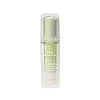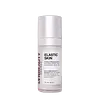What's inside
What's inside
 Key Ingredients
Key Ingredients

 Benefits
Benefits

 Concerns
Concerns

No concerns
 Ingredients Side-by-side
Ingredients Side-by-side

Water
Skin ConditioningAcetyl Hexapeptide-8
HumectantTripeptide-1
Skin ConditioningNiacinamide
SmoothingSh-Oligopeptide-1
Skin ConditioningGlycerin
HumectantHydroxypropyl Cyclodextrin
MaskingPalmitoyl Tripeptide-38
Skin ConditioningCopper Tripeptide-1
Skin ConditioningDextran
Tripeptide-32
Skin ConditioningSalix Nigra Bark Extract
Skin ProtectingLecithin
EmollientAcetyl Glutamine
Skin ConditioningSh-Oligopeptide-2
Skin ConditioningSh-Polypeptide-1
Skin ConditioningSh-Polypeptide-9
Skin ConditioningSh-Polypeptide-11
Glyceryl Acrylate/Acrylic Acid Copolymer
HumectantBacillus/Folic Acid Ferment Filtrate Extract
AntioxidantAloe Barbadensis Leaf Extract
EmollientXanthan Gum
EmulsifyingRoyal Jelly
Ectoin
Skin ConditioningPhenoxyethanol
PreservativeCaprylyl Glycol
EmollientGlyceryl Caprylate
EmollientLactic Acid/Glycolic Acid Copolymer
Skin ConditioningPhenylpropanol
MaskingPalmitoyl Sh-Octapeptide-24 Amide
Skin ConditioningPolyvinyl Alcohol
Palmitoyl Sh-Tripeptide-5 Norisoleucyl Sh-Nonapeptide-1
Skin ConditioningSodium Hyaluronate
HumectantButylene Glycol
HumectantCarbomer
Emulsion StabilisingDipotassium Glycyrrhizate
HumectantTocopheryl Acetate
AntioxidantEthylhexylglycerin
Skin ConditioningDisodium EDTA
Water, Acetyl Hexapeptide-8, Tripeptide-1, Niacinamide, Sh-Oligopeptide-1, Glycerin, Hydroxypropyl Cyclodextrin, Palmitoyl Tripeptide-38, Copper Tripeptide-1, Dextran, Tripeptide-32, Salix Nigra Bark Extract, Lecithin, Acetyl Glutamine, Sh-Oligopeptide-2, Sh-Polypeptide-1, Sh-Polypeptide-9, Sh-Polypeptide-11, Glyceryl Acrylate/Acrylic Acid Copolymer, Bacillus/Folic Acid Ferment Filtrate Extract, Aloe Barbadensis Leaf Extract, Xanthan Gum, Royal Jelly, Ectoin, Phenoxyethanol, Caprylyl Glycol, Glyceryl Caprylate, Lactic Acid/Glycolic Acid Copolymer, Phenylpropanol, Palmitoyl Sh-Octapeptide-24 Amide, Polyvinyl Alcohol, Palmitoyl Sh-Tripeptide-5 Norisoleucyl Sh-Nonapeptide-1, Sodium Hyaluronate, Butylene Glycol, Carbomer, Dipotassium Glycyrrhizate, Tocopheryl Acetate, Ethylhexylglycerin, Disodium EDTA
Water
Skin ConditioningButylene Glycol
HumectantGlycerin
HumectantCaprylic/Capric Triglyceride
MaskingSqualane
EmollientDiheptyl Succinate
EmollientPentylene Glycol
Skin Conditioning1,2-Hexanediol
Skin ConditioningHelianthus Annuus Seed Oil
EmollientDioscorea Villosa Root Extract
Skin ConditioningCopper Tripeptide-1
Skin ConditioningOligopeptide-1
Skin ConditioningNicotiana Benthamiana Hexapeptide-40 Sh-Polypeptide-76
Skin ConditioningNicotiana Benthamiana Hexapeptide-40 Sh-Polypeptide-47
Skin ConditioningAcetyl Sh-Hexapeptide-5 Amide Acetate
Skin ConditioningCeramide NP
Skin ConditioningNiacinamide
SmoothingCentella Asiatica Extract
CleansingBeta-Glucan
Skin ConditioningSodium Hyaluronate
HumectantHaematococcus Pluvialis Extract
AntioxidantSodium PCA
HumectantAnanas Sativus Fruit Extract
Skin ConditioningPanthenol
Skin ConditioningAllantoin
Skin ConditioningBetaine
HumectantBisabolol
MaskingZinc PCA
HumectantC12-20 Alkyl Glucoside
EmulsifyingC14-22 Alcohols
Emulsion StabilisingSodium Polyacrylate
AbsorbentCapryloyl Glycerin/Sebacic Acid Copolymer
Skin ConditioningCarbomer
Emulsion StabilisingSorbitan Olivate
EmulsifyingCellulose Gum
Emulsion StabilisingHydrogenated Lecithin
EmulsifyingCetearyl Olivate
Mannitol
HumectantPhosphatidylcholine
EmulsifyingCetyl Alcohol
EmollientDecyl Glucoside
CleansingDipotassium Phosphate
BufferingPropanediol
SolventSodium Chloride
MaskingSodium Hydroxide
BufferingSodium Phytate
Tocopherol
AntioxidantXanthan Gum
EmulsifyingPotassium Phosphate
BufferingPotassium Sorbate
PreservativeSodium Benzoate
MaskingPhenoxyethanol
PreservativeEthylhexylglycerin
Skin ConditioningHydroxyacetophenone
AntioxidantWater, Butylene Glycol, Glycerin, Caprylic/Capric Triglyceride, Squalane, Diheptyl Succinate, Pentylene Glycol, 1,2-Hexanediol, Helianthus Annuus Seed Oil, Dioscorea Villosa Root Extract, Copper Tripeptide-1, Oligopeptide-1, Nicotiana Benthamiana Hexapeptide-40 Sh-Polypeptide-76, Nicotiana Benthamiana Hexapeptide-40 Sh-Polypeptide-47, Acetyl Sh-Hexapeptide-5 Amide Acetate, Ceramide NP, Niacinamide, Centella Asiatica Extract, Beta-Glucan, Sodium Hyaluronate, Haematococcus Pluvialis Extract, Sodium PCA, Ananas Sativus Fruit Extract, Panthenol, Allantoin, Betaine, Bisabolol, Zinc PCA, C12-20 Alkyl Glucoside, C14-22 Alcohols, Sodium Polyacrylate, Capryloyl Glycerin/Sebacic Acid Copolymer, Carbomer, Sorbitan Olivate, Cellulose Gum, Hydrogenated Lecithin, Cetearyl Olivate, Mannitol, Phosphatidylcholine, Cetyl Alcohol, Decyl Glucoside, Dipotassium Phosphate, Propanediol, Sodium Chloride, Sodium Hydroxide, Sodium Phytate, Tocopherol, Xanthan Gum, Potassium Phosphate, Potassium Sorbate, Sodium Benzoate, Phenoxyethanol, Ethylhexylglycerin, Hydroxyacetophenone
 Reviews
Reviews

Ingredients Explained
These ingredients are found in both products.
Ingredients higher up in an ingredient list are typically present in a larger amount.
Butylene Glycol (or BG) is used within cosmetic products for a few different reasons:
Overall, Butylene Glycol is a safe and well-rounded ingredient that works well with other ingredients.
Though this ingredient works well with most skin types, some people with sensitive skin may experience a reaction such as allergic rashes, closed comedones, or itchiness.
Learn more about Butylene GlycolCarbomer is a polymer of acrylic acid. Its main role is to create a gel consistency.
A high amount of carbomer can cause pilling or balling up of products. Don't worry, most products contain 1% or less of carbomer.
Copper Tripeptide-1 (GHK-Cu) is a skin repairing ingredient known for its ability to boost collagen, improve firmness, and support skin regeneration.
It is a complex made up of a naturally occurring peptide (glycine-histidine-lysine) and copper, an essential trace element.
While studying wound healing, researchers noticed GHK-Cu stimulated hair follicle enlargement and growth by keeping hair in its active growth phase longer. This has made it a promising ingredient for hair regrowth treatments.
Some people have reported increased facial hair. While GHK-Cu can make your hair follicles bigger, it usually doesn’t turn soft, barely-visible facial hairs into thick, dark ones.
Anecdotal reports suggest that overusing copper peptides might lead to premature aging due to excess free copper or enzyme imbalances. This claim isn’t backed by large-scale studies.
Unfortunately, there are limited human studies for this ingredient. While early results are promising, many studies are either small, in-vitro, or not rigorously controlled.
For example, there is a 1998 study that explored the effects of copper tripeptide, vitamin C, tretinoin, and melatonin on skin repair and collagen synthesis.
After one month, increased procollagen production was seen in 7 out of 10 participants using copper tripeptide (more than those using vitamin C, melatonin, or tretinoin.
While the study was exploratory, it offers early evidence that copper tripeptide may support collagen production. Larger, well-designed trials are still needed to confirm its potential and understand individual responses.
Read more about other common types of peptides here:
Learn more about Copper Tripeptide-1Ethylhexylglycerin (we can't pronounce this either) is commonly used as a preservative and skin softener. It is derived from glyceryl.
You might see Ethylhexylglycerin often paired with other preservatives such as phenoxyethanol. Ethylhexylglycerin has been found to increase the effectiveness of these other preservatives.
Glycerin is already naturally found in your skin. It helps moisturize and protect your skin.
A study from 2016 found glycerin to be more effective as a humectant than AHAs and hyaluronic acid.
As a humectant, it helps the skin stay hydrated by pulling moisture to your skin. The low molecular weight of glycerin allows it to pull moisture into the deeper layers of your skin.
Hydrated skin improves your skin barrier; Your skin barrier helps protect against irritants and bacteria.
Glycerin has also been found to have antimicrobial and antiviral properties. Due to these properties, glycerin is often used in wound and burn treatments.
In cosmetics, glycerin is usually derived from plants such as soybean or palm. However, it can also be sourced from animals, such as tallow or animal fat.
This ingredient is organic, colorless, odorless, and non-toxic.
Glycerin is the name for this ingredient in American English. British English uses Glycerol/Glycerine.
Learn more about GlycerinNiacinamide is a multitasking form of vitamin B3 that strengthens the skin barrier, reduces pores and dark spots, regulates oil, and improves signs of aging.
And the best part? It's gentle and well-tolerated by most skin types, including sensitive and reactive skin.
You might have heard of "niacin flush", or the reddening of skin that causes itchiness. Niacinamide has not been found to cause this.
In very rare cases, some individuals may not be able to tolerate niacinamide at all or experience an allergic reaction to it.
If you are experiencing flaking, irritation, and dryness with this ingredient, be sure to double check all your products as this ingredient can be found in all categories of skincare.
When incorporating niacinamide into your routine, look out for concentration amounts. Typically, 5% niacinamide provides benefits such as fading dark spots. However, if you have sensitive skin, it is better to begin with a smaller concentration.
When you apply niacinamide to your skin, your body converts it into nicotinamide adenine dinucleotide (NAD). NAD is an essential coenzyme that is already found in your cells as "fuel" and powers countless biological processes.
In your skin, NAD helps repair cell damage, produce new healthy cells, support collagen production, strengthen the skin barrier, and fight environmental stressors (like UV and pollution).
Our natural NAD levels start to decline with age, leading to slower skin repair, visible aging, and a weaker skin barrier. By providing your skin niacinamide, you're recharging your skin's NAD levels. This leads to stronger, healthier, and younger looking skin.
Another name for vitamin B3 is nicotinamide. This vitamin is water-soluble and our bodies don't store it. We obtain Vitamin B3 from either food or skincare. Meat, fish, wheat, yeast, and leafy greens contain vitamin B3.
The type of niacinamide used in skincare is synthetically created.
Learn more about NiacinamidePhenoxyethanol is a preservative that has germicide, antimicrobial, and aromatic properties. Studies show that phenoxyethanol can prevent microbial growth. By itself, it has a scent that is similar to that of a rose.
It's often used in formulations along with Caprylyl Glycol to preserve the shelf life of products.
Sodium Hyaluronate is hyaluronic acid's salt form. It is commonly derived from the sodium salt of hyaluronic acid.
Like hyaluronic acid, it is great at holding water and acts as a humectant. This makes it a great skin hydrating ingredient.
Sodium Hyaluronate is naturally occurring in our bodies and is mostly found in eye fluid and joints.
These are some other common types of Hyaluronic Acid:
Learn more about Sodium HyaluronateWater. It's the most common cosmetic ingredient of all. You'll usually see it at the top of ingredient lists, meaning that it makes up the largest part of the product.
So why is it so popular? Water most often acts as a solvent - this means that it helps dissolve other ingredients into the formulation.
You'll also recognize water as that liquid we all need to stay alive. If you see this, drink a glass of water. Stay hydrated!
Learn more about WaterXanthan gum is used as a stabilizer and thickener within cosmetic products. It helps give products a sticky, thick feeling - preventing them from being too runny.
On the technical side of things, xanthan gum is a polysaccharide - a combination consisting of multiple sugar molecules bonded together.
Xanthan gum is a pretty common and great ingredient. It is a natural, non-toxic, non-irritating ingredient that is also commonly used in food products.
Learn more about Xanthan Gum